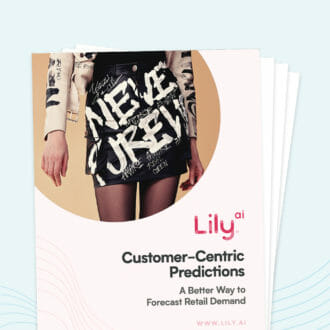With the unpredictable consumer shopping patterns and modern problems surrounding supply chains, assortment planning, web and store merchandising, shipping logistics and more, it should come as no shock that the world of demand forecasting in retail can be complex. However, no matter how tricky, it’s a game changer for retailers to plan out their inventory adequately for the coming seasons and ensure demand can be predicted in a way that allows for an increase in full-margin sales.
One of the best ways for retailers to increase full-margin sales is by making informed, customer-centric predictions about what shoppers are most likely to buy in the future.
Full-Margin Sales and Demand Forecasting
Keeping items at full-margin and avoiding situations where the listing price has to be marked down (let’s say $130 > $100 > $75) due to items not selling for whatever reason (they missed the mark on what’s trending, are no longer current, etc.), is job number one for any demand planning team.
But in order to do this successfully, most retailers do what anyone would do in the face of uncertainty about what to stock for the coming season – they look at what sold well in the past. This process of looking at what sold well in the past and then ordering more of it, or an item as close in style/as similar as possible, however, cannot happen if the team is unable to successfully identify the right items.
Demand forecasting, or the ability to identify the right items that are going to sell at the right time, is essential to retailers in order to eliminate things like overstocking, and even understocking. Why? Overstocked merchandise leads to items sitting on shelves, in storage, or having to be marked down at the end of the season. While, understocked merchandise can quickly derail the shelf health of a store and can result in a negative shopping experience for the consumer when they’re unable to get the item they want because demand for it wasn’t forecasted accurately.
The Problem with Generic Attributes
In order for retailers to more closely predict what shoppers are likely to buy in the coming months, it’s crucial for retailers to utilize a language that puts customer-driven attributes first – not legacy, generic attributes. Legacy, out-of-the-box attributes only consider part of the picture – that of the merchant, the manufacturer, or distributor – and often aren’t optimized to capture the many ways in which people in the real world actually search for products.
Consider a woman’s lace dress. Generic attributes will describe that it’s “women’s,” it’s a “dress,” and it has a “lace fabric.” They will also likely provide the colors and the size of the dress as well, but that’s about it. Yet, customers in the real world tend to want more details. Perhaps they want the lacing to be in a floral pattern or they’ll have a predetermined sense of their desired cut, sleeve length, dress length, and whether or not that lace dress is intended for a special occasion, such as a wedding.

If that lace dress isn’t attributed correctly right at item set-up, it won’t be easily found in online searches – neither via SEO/SEM nor on-site search. And it certainly won’t be recommended to a consumer who might otherwise be thrilled to add it to her shopping cart. It might not even be ordered for next season, despite its popularity, because merchandise planning and demand planning teams thought it was the “lace fabric” nature that drove the sales of it – not the fact that it was the floral pattern + midi length + sleeveless that actually got customers buying it in stores and online.
By expanding the attributes assigned to any given product to encompass the language of customers, and not merely the language of manufacturers or distributors, retailers can increase their ability to sell their shoppers what they’re actually looking for and decrease the need to mark that inventory down later.
The Importance of Customer-Centric Proxy Products
A key facet to improving demand forecasting in retail is to make the most of customer-centric product attributes in order to determine the proxy products, which are products that most closely resemble those that sold well in the past. During this process retailers will look back at previous seasons and focus on the items that sold well in the hopes of finding that success again with similar types of products. By knowing the attributes associated with the high-selling products, there’s a better chance for success.
Just as in the lace dress mentioned above, a retail e-commerce brand may find closely matching proxy products that sold well in the past. Ordering its counterpart can occur with confidence, instilled by knowing it was the combination of floral pattern + midi length + sleeveless that drove sales, thereby increasing the ability to sell the new item at full margin.
To keep this process better streamlined, teams can implement the help of machine learning (ML) in order to make better choices about upcoming seasons in a much faster, easier, and more consistent fashion.
Lily AI’s AI-powered computer vision gathers proxy products and assigns a similarity value to better help retailers accurately forecast demand for brand new product lines. When fed back into the supply chain, this information helps replace wholesale pre-orders with a leaner, demand-led, made-to-order model that fuels product development with AI to launch lines that are guaranteed to sell out quickly.
Better Your Customer-Centric Predictions Today

